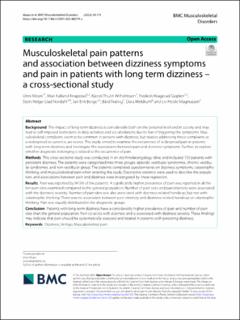| dc.contributor.author | Moen, Unni | |
| dc.contributor.author | Knapstad, Mari Kalland | |
| dc.contributor.author | Wilhelmsen, Kjersti Thulin | |
| dc.contributor.author | Goplen, Frederik Kragerud | |
| dc.contributor.author | Nordahl, Stein Helge Glad | |
| dc.contributor.author | Berge, Jan Erik | |
| dc.contributor.author | Natvig, Bård | |
| dc.contributor.author | Magnussen, Liv Heide | |
| dc.date.accessioned | 2023-04-04T10:42:02Z | |
| dc.date.available | 2023-04-04T10:42:02Z | |
| dc.date.created | 2023-03-27T12:17:34Z | |
| dc.date.issued | 2023 | |
| dc.identifier.citation | BMC Musculoskeletal Disorders. 2023, 24:173. | en_US |
| dc.identifier.issn | 1471-2474 | |
| dc.identifier.uri | https://hdl.handle.net/11250/3062050 | |
| dc.description.abstract | Background
The impact of long-term dizziness is considerable both on the personal level and in society and may lead to self-imposed restrictions in daily activities and social relations due to fear of triggering the symptoms. Musculoskeletal complaints seem to be common in persons with dizziness, but studies addressing these complaints as a widespread occurrence, are scarce. This study aimed to examine the occurrence of widespread pain in patients with long-term dizziness and investigate the associations between pain and dizziness symptoms. Further, to explore whether diagnostic belonging is related to the occurrence of pain.
Methods
This cross-sectional study was conducted in an otorhinolaryngology clinic and included 150 patients with persistent dizziness. The patients were categorized into three groups: episodic vestibular syndromes, chronic vestibular syndromes, and non-vestibular group. The patients completed questionnaires on dizziness symptoms, catastrophic thinking, and musculoskeletal pain when entering the study. Descriptive statistics were used to describe the population, and associations between pain and dizziness were investigated by linear regression.
Results
Pain was reported by 94.5% of the patients. A significantly higher prevalence of pain was reported in all the ten pain sites examined compared to the general population. Number of pain sites and pain intensity were associated with the dizziness severity. Number of pain sites was also associated with dizziness-related handicap, but not with catastrophic thinking. There was no association between pain intensity and dizziness-related handicap or catastrophic thinking. Pain was equally distributed in the diagnostic groups.
Conclusion
Patients with long-term dizziness have a considerably higher prevalence of pain and number of pain sites than the general population. Pain co-exists with dizziness and is associated with dizziness severity. These findings may indicate that pain should be systematically assessed and treated in patients with persisting dizziness. | en_US |
| dc.language.iso | eng | en_US |
| dc.publisher | BMC | en_US |
| dc.rights | Navngivelse 4.0 Internasjonal | * |
| dc.rights.uri | http://creativecommons.org/licenses/by/4.0/deed.no | * |
| dc.title | Musculoskeletal pain patterns and association between dizziness symptoms and pain in patients with long term dizziness – a cross-sectional study | en_US |
| dc.type | Peer reviewed | en_US |
| dc.type | Journal article | en_US |
| dc.description.version | publishedVersion | en_US |
| dc.rights.holder | © The Author(s) 2023. | en_US |
| dc.source.volume | 24 | en_US |
| dc.source.journal | BMC Musculoskeletal Disorders | en_US |
| dc.identifier.doi | 10.1186/s12891-023-06279-z | |
| dc.identifier.cristin | 2137166 | |
| dc.source.articlenumber | 173 | en_US |
| cristin.ispublished | true | |
| cristin.fulltext | original | |
| cristin.qualitycode | 1 | |

